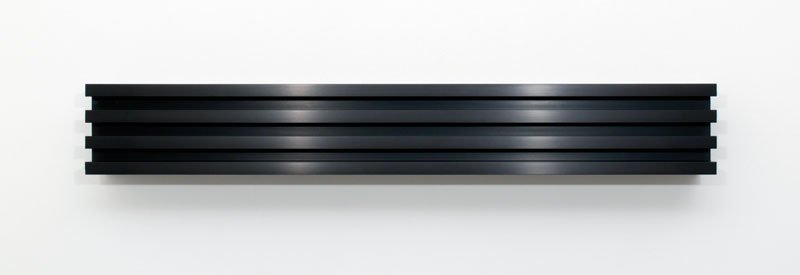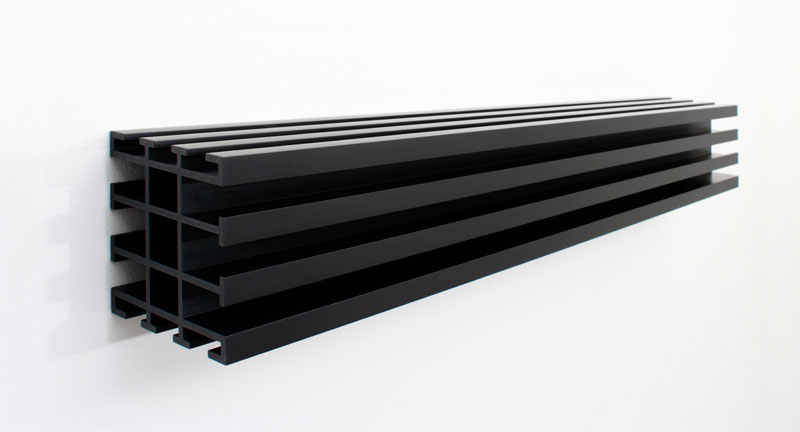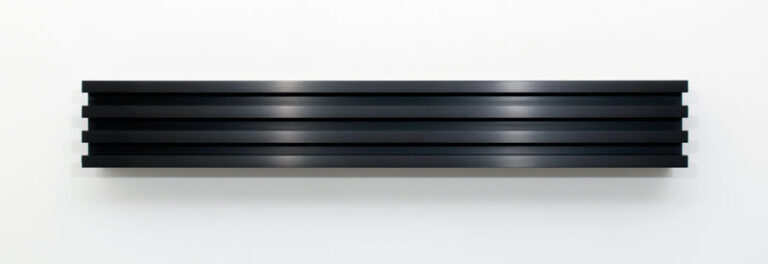



Edition of 12, HC 5/5
5 7/8 x 41 3/8 x 5 7/8 inches (15 x 105 x 15 cm)
Stamped and numbered
(Inventory #29400)
Edition of 12, HC 5/5
5 7/8 x 41 3/8 x 5 7/8 inches (15 x 105 x 15 cm)
Stamped and numbered
(Inventory #29400)

“One day, I asked Judd if he had a project he wanted to do, and he said, ‘Yes, a piece that is simple but complex — no screws or bolts, just a single piece of metal…’
But he immediately warned me: ‘…it is expensive to do; we need to order 200 meters minimum of extruded aluminum.’ This did not frighten me at all, quite the contrary. I was thrilled to undertake this adventure with Don. And so it happened. The process took two years to finish. The result was a wonderful piece conceptually condensed into a typical Judd.”
Jörg Schellmann
“Judd sought explicitness and intelligibility, not content. The intake of clear vision would be content enough, could it be achieved. And that experience would not exclude perceptual illusion, contrary to what some critics have said, but would set illusion plainly against the stable background that supports it.”
Kenneth Baker
In 1991, Donald Judd created a series of works in aluminum. As opposed to his other works (often constructed from multiple elements of wood, metal, and/or acrylic sheeting that were attached together), this piece was created by pressing heated aluminum through a die (a process called extrusion) to create a specific form, with the dimensions of 15 x 105 x 15 centimeters. This extruded aluminum form was then anodized. Judd chose the anodizing process as opposed to other painting methods because he liked “the color to be in the material” and that, “Anodized aluminum, even though it’s a surface, too, is a little better to me, because at least a little layer of it is color in the material” (from an interview by Angeli Janhsen for “Donald Judd,” Kunstverein St. Gallen, Switzerland, 1990). Judd considered color, material, and space to be the main aspects of visual art. In this 1991 work, these elements (and their processes of fabrication) have been chosen carefully so as to create a specific and unified experience with light, openness, shadow, and solidity.
Donald Judd revolutionized practices and attitudes surrounding art making and the exhibition of art, primarily advocating for the permanent installation of works by artists in carefully selected environments. Judd achieved this goal for his own work and that of his colleagues at both his studio and residence at 101 Spring Street in New York and in various locations in and around Marfa, Texas.
Born Donald Clarence Judd on June 3, 1928, in Excelsior Springs, Missouri, the artist served in the United States Army in Korea, then attended The College of William and Mary, Williamsburg, Virginia; the Art Students League, New York; and Columbia University, New York, where he received a B.S. in Philosophy, cum laude, in 1953.
Judd’s first solo exhibition was in 1957 at the Panoras Gallery, New York, the same year he began graduate studies in art history at Columbia University. Over the next decade, Judd worked as a critic for ARTnews, Arts Magazine, and Art International; his subsequent theoretical writings on art and exhibition practices would prove to be some of his most important and lasting legacies.
Beginning in the 1960s, Judd exhibited regularly and widely at galleries in New York as well as across the U.S., Europe, and Japan. During his lifetime, major exhibitions of Judd’s work occurred at The Whitney Museum of American Art, New York (1968, 1988); The National Gallery of Canada, Ottawa (1975); Stedelijk Van Abbemuseum, Eindhoven, The Netherlands (1987); and The Saint Louis Art Museum (1991), among other museum exhibitions. More recent exhibitions have taken place at The Museum of Modern Art, Saitama, Japan (1999); Walker Art Center, Minneapolis (2001); and Tate Modern, London (2004), among others.
Judd received grants and awards from the National Endowment for the Arts, the Swedish Institute, and the John Guggenheim Memorial Foundation, among others. He married dancer Julie Finch in 1964 (later divorced) and had two children, son Flavin Starbuck Judd in 1968 and daughter Rainer Yingling Judd in 1970. While still maintaining his building in New York at 101 Spring Street, Judd moved to Marfa, Texas, in 1972, where he would live and work until his death on February 12, 1994.
10 Newbury Street, Boston, Massachusetts 02116
617-262-4490 | info@krakowwitkingallery.com
The gallery is free and open to the public Tuesday – Saturday, 10am – 5:30pm